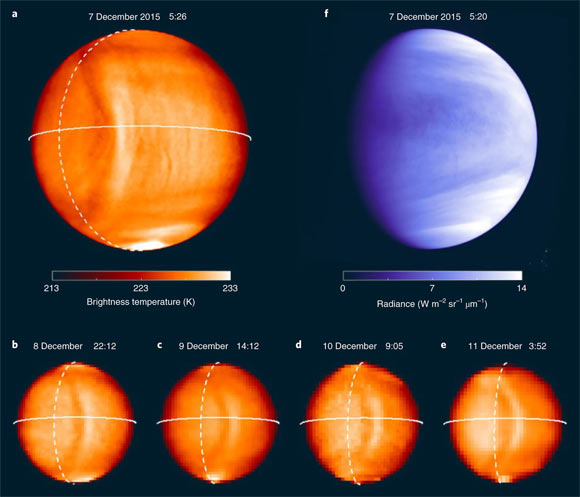The gravity of a large object in space can keep a smaller object from spinning, a phenomenon called tidal locking. The discovery and characterization of Earth-sized planets that are in, or near, a tidally locked state are of crucial importance to understanding evolution of terrestrial planets. For this purpose Venus is a clear analogue.

This composite image, taken by JAXA’s Akatsuki spacecraft, shows Venus. Image credit: JAXA / ISAS / DARTS / Damia Bouic.
“We think of the atmosphere as a thin, almost separate layer on top of a planet that has minimal interaction with the solid planet,” said Professor Stephen Kane, an astrophysicist in the Department of Earth and Planetary Sciences at the University of California, Riverside.
“Venus’ powerful atmosphere teaches us that it’s a much more integrated part of the planet that affects absolutely everything, even how fast the planet rotates.”
Venus takes 243 Earth days to rotate one time, but its atmosphere circulates the planet every 4 days.
Extremely fast winds cause the atmosphere to drag along the surface of the planet as it circulates, slowing its rotation while also loosening the grip of the Sun’s gravity.
Slow rotation in turn has dramatic consequences for the sweltering Venusian climate, with average temperatures of up to 475 degrees Celsius (900 degrees Fahrenheit).

Data from JAXA’s Akatsuki spacecraft showing the brightness temperature and UV brightness of the Venusian disk: (a-f) the brightness temperature (a-e) and UV brightness (f) of the Venusian disk; the bow-shaped structure is an atmospheric gravity wave passing over the surface topography. Image credit: S.R. Kane, doi: 10.1038/s41550-022-01626-x.
“It’s incredibly alien, a wildly different experience than being on Earth. Standing on the surface of Venus would be like standing at the bottom of a very hot ocean. You couldn’t breathe on it,” Professor Kane said.
One reason for the heat is that nearly all of the Sun’s energy absorbed by the planet is soaked up by Venus’ atmosphere, never reaching the surface. This means that a rover with solar panels like the one NASA sent to Mars wouldn’t work.
The Venusian atmosphere also blocks the Sun’s energy from leaving the planet, preventing cooling or liquid water on its surface, a state known as a runaway greenhouse effect.
It is unclear whether being partially tidally locked contributes to this runaway greenhouse state, a condition which ultimately renders a planet uninhabitable by life as we know it.
Not only is it important to gain clarity on this question to understand Venus, it is important for studying the exoplanets likely to be targeted for future NASA missions.
Most of the planets likely to be observed with the recently launched NASA/ESA/CSA James Webb Space Telescope are very close to their stars, even closer than Venus is to the Sun. Therefore, they’re also likely to be tidally locked.
Since humans may never be able to visit exoplanets in person, making sure computer models account for the effects of tidal locking is critical.
“Venus is our opportunity to get these models correct, so we can properly understand the surface environments of planets around other stars,” Professor Kane said.
“We aren’t doing a good job of considering this right now. We’re mostly using Earth-type models to interpret the properties of exoplanets. Venus is waving both arms around saying, ‘look over here!’”
“Gaining clarity about the factors that contributed to a runaway greenhouse state on Venus, Earth’s closest planetary neighbor, can also help improve models of what could one day happen to Earth’s climate.”
“Ultimately, my motivation in studying Venus is to better understand the Earth.”
The study was published in the journal Nature Astronomy.
_____
S.R. Kane. Atmospheric dynamics of a near tidally locked Earth-sized planet. Nat Astron, published online April 20, 2022; doi: 10.1038/s41550-022-01626-x







